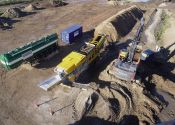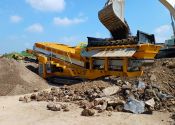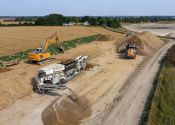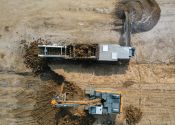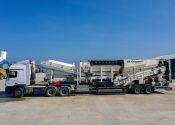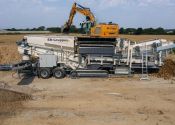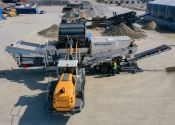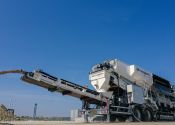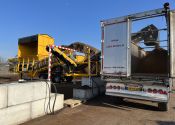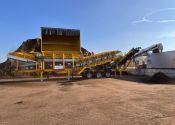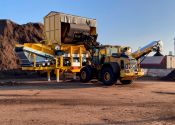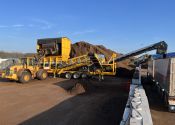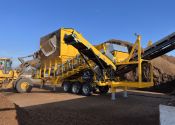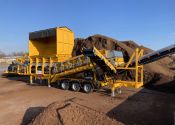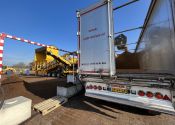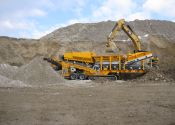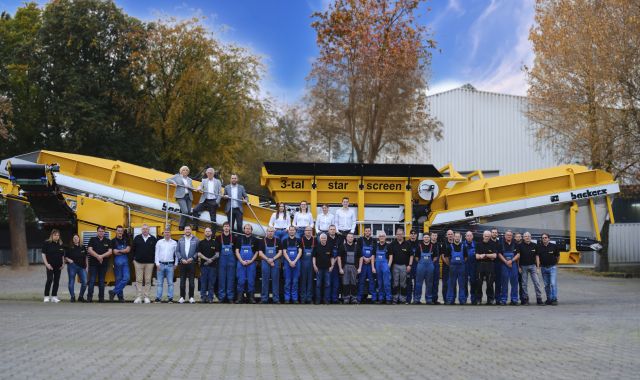
News
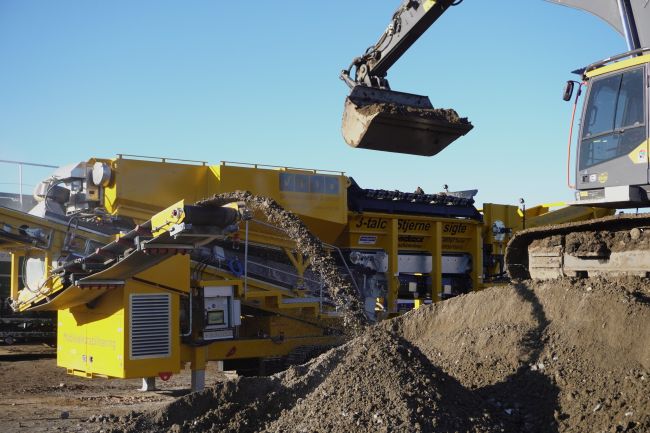

Mobile Screening and Mixing Machine impresses in Denmark with performance and quality
Mobile Screening and Mixing Machine impresses in Denmark with performance and quality
The heart of our crawler-mounted screening and mixing machine 3-talc is its proven star screen technology, which ensures particularly efficient and uniform material separation. During the screening process, the material is loosened, providing optimal preparation for the subsequent mixing process. This allows the amount of additives to be reduced – even with cohesive or wet soils. Processing takes place in a mobile unit, saving time and avoiding unnecessary transport. With a capacity of 250 t/h, our screening and mixing machine is especially economical for large-scale projects.
Successful in Operation at Vils Entreprenørforretning A/S
In September 2025, the screening and mixing machine 3-talc was delivered to our Danish customer Vils Entreprenørforretning A/S. Just a few weeks after commissioning, it became clear: the machine impresses across the board. According to customer feedback, both the performance and the quality of material processing are outstanding. The system is used by the Danish company wherever construction materials from building and infrastructure projects need to be professionally processed and reused.
From Waste to Resource – Economical and Sustainable
The use of the 3-talc is particularly impressive for stabilizing wet soils and drilling slurries with lime. Materials that would otherwise be classified as costly waste are transformed on-site into reusable construction materials.
Thanks to its mobile design, the machine can be quickly operated at different locations – a major advantage for companies needing flexibility across various projects. The result is reduced transport requirements, lower disposal costs, and a significant reduction in CO₂ emissions. Waste becomes a valuable resource – fully in line with a functioning circular economy.
Innovative technology with vision – the advantages of the 3-talc
The screening and mixing machine 3-talc combines our decades of experience in star screen technology with state-of-the-art machinery:
- Combined screening and mixing technology – efficient material processing in a single operation
• Proven starscreen system – reliable separation even with cohesive materials
• High capacity of 250 t/h – ideal for large-scale, cost-efficient projects
• Crawler-mounted mobility – full flexibility on any construction site
• Maximum material reuse – for sustainable soil treatment - Minimal use of additives – reduces the costs significantly
• Quick conversion to a 3-fraction star screen machine – versatile and adaptable
• On-site processing – saves time, transport, and costs
This versatility makes the machine an ideal solution for applications such as soil stabilization, liquid soil production, or the screening of recycled construction materials.
Strong Scandinavian demand for our starscreen technology
In recent years, our star screen technology has become firmly established in Scandinavia. The region’s construction and recycling industries place great emphasis on environmental awareness, resource efficiency, and technological reliability – values that perfectly align with our philosophy. At our customer Vils Entreprenørforretning A/S, the 3-talc demonstrates impressively how mobile screening technology enables sustainable operations without compromising on performance or quality.
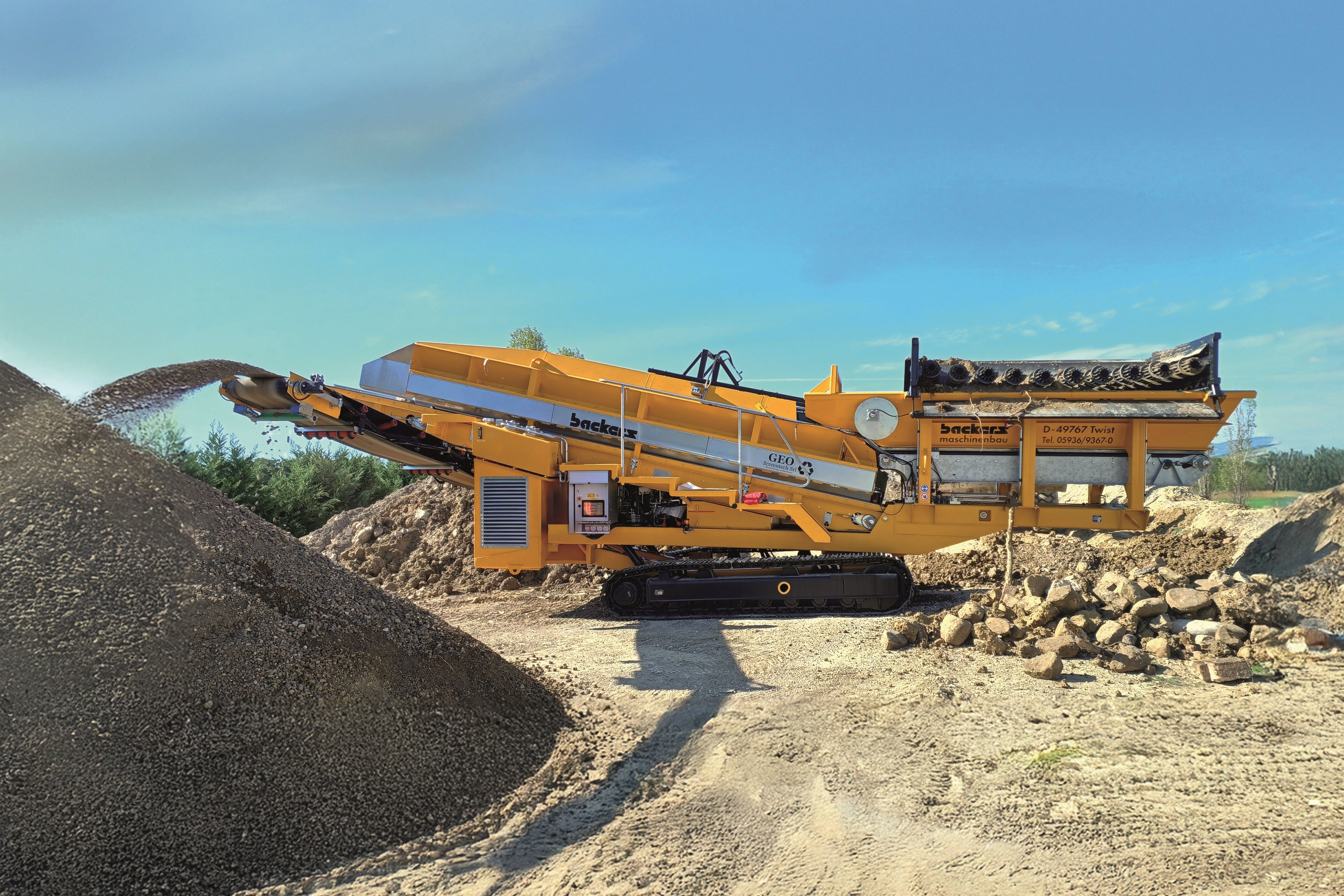
2-ta with Grizzlyscreen – a powerful combination
2-ta with Grizzlyscreen – a powerful combination
Our track-mounted Starscreen 2-ta with Grizzlyscreen impresses with high screening performance, a well-thought-out design, and versatile applications. Whether in earthworks, recycling, or soil preparation – wherever robust and efficient screening technology is required, the continuously improved Starscreen 2-ta with the additional Grizzlyscreen option sets new standards. Thanks to its sturdy construction and innovative technical features, this machine effortlessly masters even the most challenging operating conditions.
Technical highlights at a glance:
- Suitable for cohesive materials
- Effective preseparation with Grizzlyscreen
- Intensive cleaning during the screening process
- Impressive performance of up to 200 t/h
- Track-mounted screening machine with adjustable angle
- Also suitable for challenging terrain
- Integrated remote maintenance for fast service support
The Grizzlyscreen, which we have been manufacturing since 2016, has been significantly further developed in recent years. It can be powered either hydraulically or electrically and equipped with 8 or 10 shafts. It separates coarse material directly before the feed point, noticeably reducing the load on downstream processing. Especially with clayey or cohesive soil, the Grizzlyscreen provides optimal preparation for the subsequent screening process.
Our Starscreen Machine 2-ta with Grizzlyscreen is a powerful combination that has proven itself in recent years, for example in Italy, outperforming many competitors. However, the Grizzlyscreen was not only developed as an additional option for our 2-fraction star screening machines – it has also been successfully used for many years on our 3-fraction star screening machines.
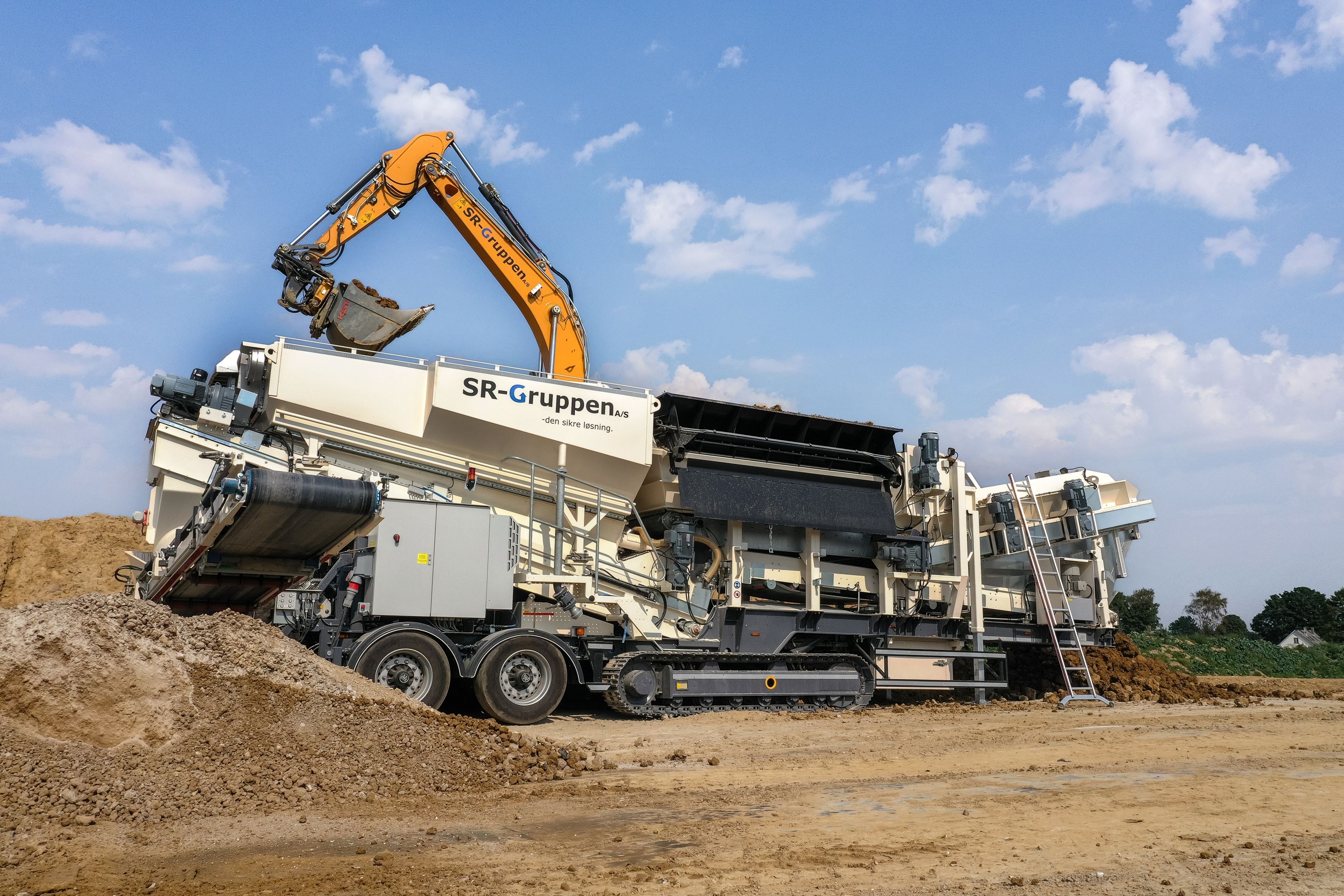
Electric Screening and Mixing Machine
Electric Screening and Mixing Machine
In the summer of 2024, the Danish construction company SR-Gruppen A/S received a fully electric screening and mixing machine from the German manufacturer Backers. With this innovative technology, SR-Gruppen A/S is raising the standard for environmentally friendly road construction to a new level. This advanced screening and mixing technology from Backers makes it possible to process and reuse up to 80% of the excavated material from cable trenches directly on site. This significantly reduces material requirements and greatly lowers the CO₂ emissions of the construction project – a milestone for sustainable road construction. Since 2022, SR-Gruppen A/S has already been using a wheel- and track-mounted screening and mixing machine from Backers. This earlier model was successfully adapted to Denmark’s cohesive soils and was still powered by a diesel-hydraulic system.
The Backers machine is a true innovation in road construction. Fully electric and mobile – with both wheel and track drives – it can be deployed flexibly and delivers maximum efficiency. After the hopper is filled, the material is processed by a star screen, which first separates the coarse fraction (> 80 mm) from the excavated material. The screened material is now loosened and then precisely weighed via a belt scale before being transported to the mixing unit. There, it is combined only with the exact amount of binding agents, such as lime or cement, needed. This allows for maximum reuse of materials while minimizing the addition of supplementary substances. Flexible on-site operation also saves long transport routes and reduces construction costs – an economical and environmentally friendly solution.
The fully electric screening and mixing machine from Backers operates with zero emissions and sets a new benchmark for ecological construction. A swiveling discharge conveyor ensures that the processed material can be optimally distributed on the construction site. With an impressive output of up to 250 tonnes per hour, the machine is also ideally suited for large projects and enables fast processing directly at the job site. The star screen technology from Backers Maschinenbau GmbH efficiently screens cohesive soils with high throughput, a key requirement for on-site use.
SR-Gruppen A/S and Backers share the goal of transforming excavated materials entirely into valuable raw materials, thereby reducing dependence on new resources in the long term. Lime-stabilized clay soil has proven to be a key element in sustainable construction, noticeably reducing CO₂ emissions, transport needs, and construction costs. By deploying the fully electric screening and mixing machine, SR-Gruppen A/S sees itself as a pioneer in a construction method that combines innovation, efficiency, and environmental responsibility.

New Development 3-mao-17e for waste wood, compost or peat
New Development 3-mao-17e for waste wood, compost or peat
The company Backers Maschinenbau GmbH in Twist is a manufacturer of starscreens as well as screening and mixing machines. For the screening of shredded waste wood, compost or peat, Backers has now manufactured a 3-fraction starscreen with 1.70m screening width with a long fine grain belt to the rear. The machine is wheel-mobile and can thus transfer the fine material directly into a truck with high capacity.
The machine is built for use in the port of Papenburg and is operated by Bol Peat, a subsidiary of Klasmann-Deilmann GmbH. The starscreen 3-mao-17e can screen up to 200m³ of fines in one hour. This allows the trucks to be loaded as quickly as possible. The dust encapsulation over the approx. 10m³ hopper minimizes dust emissions in the port. The drive is electric, using one 125 and one 63A plug. (380/480V delta voltage, 660/690V star voltage).
The machine was designed as a semi-trailer version with a 3-axle chassis. The special feature of the machine is already in the name: "o" stands here for "opposite", here the fine fraction belt and the middle fraction belt are interchanged. Here, the fines are discharged to the rear. The middle fraction is discharged to the side at a height of approx. 3.60m. The machine screens the coarse grain at a fraction of 0-60/80mm (for length parts +/- 160/180mm) and in the fine grain at 0-13/15mm. The fines are loaded directly into a truck over the specially extended fine fraction belt after the screening process, the transfer takes place at a height of approx. 5.10m.
In working position, the machine has gigantic dimensions of 22.30 x 5.90 x 6.80m. (LxWxH)

Producing fluidised soil (CLSM) on site

Producing fluidised soil (CLSM) on site
The 3-fraction starscreen machine can also be used as a screening and mixing machine for the production of stabilised soil and for the production of fluidised soil following a brief modification process. Thanks to its wheel/crawler track design, the machine can be set up quickly on site and can change location in next to no time. The machine uses a diesel-hydraulic drive. The space required for the machine is relatively small. A silo with compound can be set up directly next to or at a short distance from the machine. The machine is usually set up right next to the excavated material and filled by means of an excavator. Thus, one truck mixer can be filled approximately every 10 minutes.
The excavated earth is filled into the hopper of the screening and mixing machine using an excavator. The starscreen is then used to screen at 20, 30... or 60 mm and the coarse parts fall off in front of the machine. The screened, fine soil falls onto the lower belt in a loosened-up state, is transported to the hammer roller and weighed.
Via the CANBUS controller and lower belt scales, the compound is also conveyed to the hammer roller as per the setting by two dosing screws.
Fluidised soil production control system with computer and printer for delivery notes.
The hammer roller crushes the remaining agglomerates again and the soil is mixed with the compound. The mixture is then collected by a collector belt and conveyed to the fine-grain discharge belt. The fine-grain discharge belt conveys the mixture to the side, into a truck mixer (it can also be transferred to another conveyor belt and from there into the truck mixer). When it is transferred to the truck mixer, the amount of water previously calculated is pumped into the truck mixer at about the same time (regulated by the CANBUS controller).

Pre-Screening Channel Sludge Protects Sludge Pumps from Contamination

Pre-Screening Channel Sludge Protects Sludge Pumps from Contamination
An excavator is used to remove the channel sludge from the boat and load it directly into the hopper of the starscreen. The starscreen, with a screening surface of 1.7 meters wide by 8 meters long, removes the refuse from the sludge. After screening, the sludge is fed directly into (3) pumps which pump it onto a field, located a few hundred meters away.
This system gives you the ability to load up to (9) tons of material per minute into the starscreen hopper for screening. Typically about 1% of the input material has a fractional size over 30mm X 160mm and is considered refuse. During the screening process channel water is sprayed over the star deck to expedite screening. This additional moisture makes it advantageous to pump the screened sludge over a greater distance to allow better material flow into the sludge field.

New dry recycling process for soil and mixed construction waste processing

New dry recycling process for soil and mixed construction waste processing
The combination in question consists of starscreen 3-mta and a wind sifter. It can be expanded by an impact crusher. The 3-fraction starscreen has a fine and a coarse starscreen deck and a grizzlyscreen above the starscreen material hopper. First of all, the very coarse material is separated before it goes to coarse screening and is then finely screened. The grizzlyscreen separates out oversized material fractions in the course of material feeding with rotating rollers; these coarse fractions (e.g., larger stones or wood) fall off to the side of the starscreen. The 0-150/300 mm fraction passes between the individual rollers into the material hopper and is transferred from there to the coarse starscreen. Here, the coarse screen separates at 63 mm (corresponding to a length of approx. 160 mm). The 63-150/300 mm fraction drops upstream of the starscreen. In this case, it is taken over by an impact crusher and broken.
From a fraction of 0-63 mm, the fine starscreen deck then screens at 18 mm. The fine fraction (soil in this case) is discharged to the side in a large, easily removable heap.
The 18-63 mm fraction is transferred in a well-cleaned state to the wind sifter bws 5.0, which conveys the material to the side of the starscreen. During the transfer of material from the starscreen to the wind sifter, iron is removed by a magnetic roller and collected in a container. The infeed belt from the wind sifter conveys the 18-63 mm fraction via the blower nozzle. The lightweight fractions are blown by the wind sifter in the direction of flow. The wind flow can be adjusted to different speeds. The heavy fraction falls onto a conveyor belt and is discharged to the side by the wind sifter.
After the first pass, the soil and 18-63 mm fraction can be recycled. Before the second pass, the space is cleared and the >150/300 mm and 63-150/300 mm fractions are crushed and then returned to the starscreen. In the second pass, the 0-18 mm fraction consists of crushed mineral.
The starscreen, which can be moved on a wheel and caterpillar track, is moved to the pile on site by means of a caterpillar. Quick relocation is possible at any time. Wind sifting can be relocated using a wheel loader or excavator. The system can already be used in a working area of 400-500m².
The advantages in key points: - Large, heavy parts are sorted out by the grizzlyscreen with the material feed. The 0-150/300 mm fraction falls through the grizzlyscreen into the hopper in a loosened-up state. - The coarse starscreen then screens e.g. at about 63 mm with a length of 160 mm. - The 63-150/300 mm fraction and the coarse fraction are well cleaned. - The large stones and the 63-150/300 mm fraction are crushed in the impact crusher and transferred to the starscreen once again for a second pass. - The impact crusher can crush relatively coarsely because the material is then reprocessed on the 3-fraction starscreen with wind sifter bws 5.0. - The 0-63 mm fraction is screened on the finely sifting starscreen at 18 mm. Depending on cohesiveness, many soils can be screened so finely that it may be necessary to screen them at a coarser grain size. - The wind sifter is compact and very mobile. It weighs 1,800kg and can be set up using an excavator or forklift. The drive is electrically powered by a 32-ampere current source. - The material cleaned by the starscreen and wind sifter is delivered in larger heaps from which it can be easily removed by a wheel loader. - Iron is removed during the transfer from the starscreen to the wind sifter and collected in a container that can be changed quickly. - The 3-fraction starscreen can be moved on a wheel and caterpillar track, enabling it to work in confined spaces. Screening is already possible from 400m². If more space is available, the wind sifter and, if necessary, the impact crusher can be extended. - The impact crusher can be placed behind the coarse starscreen and crush the 63-150/300 mm fraction. Alternatively, an impact crusher with hopper can also be filled only during the second pass and then transfer the broken material into the hopper from the starscreen. - In the second pass, a fine grain of 0-18 mm (or finer) is screened, which then consists of minerals. This fine fraction can be added to the 18-63 mm fraction, depending on how it is used. - With an excavator for filling and a wheel loader, the combination can achieve a capacity of 100-200 tonnes per hour. - The main product is cleaned stones (18-63 mm). Furthermore, 0-18 mm soil or 0-18 mm minerals, as well as lightweight components and iron, are separated from each other. This processing technology has a high throughput capacity with low wear and drive costs. The high-quality products are easy to recycle and can also be installed on site to a great extent.

Backers: Soil recycling through screening & mixing

Backers: Soil recycling through screening & mixing
In the field of mineral waste and excavated soil, the Backers company from the Emsland region relies on the concept of “screen first, then break” or “screen first, then mix”. The soil is recycled on site with mobile machines. The costs for landfill and new material, including extraction and transport, are thus eliminated. Local resources and soil are conserved in accordance with the Soil Protection Act.
The hopper forwards the fine material (0-150/300mm) to the 6.7m long, rising stardeck, which screens and cleans for example at 45 mm. After that, the clean material (45-150/300mm) will be filled directly into an impact crusher.
Soil recycling with 2 and 3 fractions Star screens The excavated material, loamy soil and red layer are upgraded with the screening and mixing machine from Backers by screening or by screening and mixing. The newly developed “Grizzlyscreen” on the material feed hopper is equipped with strongly mounted, rotating rollers. It is filled with an excavator or wheel loader and removes large, heavy stones. Cohesive soil is loosened at the same time and then screened on the Starscreen 2-ta at 22/25 mm separation size.
Starscreen 2-ta with impact crusher The cleaned stones (left in the picture) were placed directly into the impact crusher by the Starscreen 2-ta and crushed. In this way, very clean material is produced with very high performance in a single operation, which is also used as a frost layer. The screened soil can be used as filling material.
Starscreen 3-tbl+ (with longer coarse screen) The 3-fraction Starscreen screens first coarsely and then finely. Backers offers many special solutions.
A 2-shaft breaker of the performance class 50 tons/hour with Starscreen 2-tb17 Backers Starscreens are also used for screening organic materials. Here the procedure is the other way round, crushing comes first, followed by screening. Heavy and very strong, slow-running roller crushers crush the waste wood. This process is relatively dust-free and has low fuel consumption as well as wear. Door locks, hinges and even bicycles are no problem for these heavy crushers. Metal can be separated directly. However, these crushers cannot reduce the waste wood to the desired length in a single operation. Therefore the longer pieces are transported back into the crusher by the Starscreen. With the new, patented premium star system from Backers it is possible to screen even finer (from approx. 4 mm). The screening stars can also be used as double or triple stars (see cover picture). With a triple star, for example, mineral is screened at about 70 mm. However, organic materials can also be screened with the same screen. They contain many elongated parts, which are then screened with a length of approximately 160 mm separating cut.

Screening and crushing instead of crushing and screening!

Screening and crushing instead of crushing and screening!
The final product is not the only thing that will be different!
Because of the new grizzlyscreen an alternative recycling of C&D material (especially when the soil is cohesive) is possible. The strong and rotating drums of the grizzlyscreen are fixed on one side and aerate the fine material continuously during work. The grizzylscreen will sort out bigger parts / stones of the input material.
The hopper forwards the fine material (0-150/300mm) to the 6.7m long, rising stardeck, which screens and cleans for example at 45 mm. After that, the clean material (45-150/300mm) will be filled directly into an impact crusher.
This concept has advantages in C&D and especially when recycling soil.
Grizzlyscreen, starscreen and iron separator are placed in front of the impact crusher.
This way bigger stones, iron and cohesive soil are sorted out before the material gets into the impact crusher. The impact crusher breaks down to approx. 60-100mm with high capacity and less wear and operating costs at the same time. The broken material is cubic and has minimized dust particles.
The material 0-45mm goes to a cleaning station, which screens at 10mm. At the end of the screen, a windsifter is mounted to suck out light material while an iron separator is placed at the end of the following belt.

Starscreen 2-ta with „Grizzlyscreen“

Starscreen 2-ta with „Grizzlyscreen“
Backers also adjusted the starscreen 2-ta with the new grizzlyscreen on top of the hopper.
Because of continuous rotation and an adjustable angle even bigger stones will be separated by starscreen 2-ta with grizzlyscreen before they’ll be feed into the hopper. The finesize 150/300mm will be transfer from hopper to screendeck. The material, which gets loosen by grizzlyscreen, gets screened and cleaned with high capacity on a of 6.7m long stardeck at the starscreen
By adding the grizzlyscreen the range of applications rised up. Especially by using it for recycling of soil or C&D debris the combination has a lot of advantages.
The transport measurements are 10.6 x 2.54 x 3.2m (l x w x h) by a weight of approx. 21tons.
Actually the starscreen 2-ta is adjusted with the grizzlyscreen and works in line with a 4.3m long auxiliary screendeck, windshifter and magnet to clean C&D debris. The screendeck which is used at the starscreen 2-ta has a screening size of 45mm, the auxiliary screen of 10mm. The complete line is driven by starscreen 2-ta.

Backers Maschinenbau GmbH’s demonstrating day with testing the 2-tb17 starscreen was successful.

Backers Maschinenbau GmbH’s demonstrating day with testing the 2-tb17 starscreen was successful.
The firm of Backers’ first demonstrating day was held on the new site next to the A31 motorway on 9th July 2015. Several machines were able to be demonstrated. The following mobile starscreens were exhibited: a 3-mtcf and a 3-mtb, some of which were specially equipped. The 2-hma hook lift was demonstrated in connection with the new rotary mixer. Concrete was made first of all and cast into a mould, then liquid soil after that. The new 2-tb17 starscreen was demonstrated by means of topsoil, builder’s rubble and spoil heaps of loamy soil. This machine was demonstrated with a vibrating grill, a screening deck extension and re-screening on the discharging conveyorbelt. A further fraction can be extracted by means of the screening deck extension on account of the ‘b’ version of the design, with which the over-sized grains are discharged sideways.
Furthermore, a Husmann crusher was demonstrated with timber in connection with the 3-mtb starscreen.
Backers has been making the 2-tb17 starscreen crawler with a screening width of 1.7 metres since 2012. This version was initially developed for screening organic materials. The feeding hopper holds between 7 cu. m. and 8 cu. m. of material, which it transfers to the starscreen in doses. The screening deck that measures 1.7 metres wide and 6.7 metres long achieves a high screening performance with a very good cleaning effect. The machine has a compact size for transport, despite the large screening surface. The 2-tb17 starscreen’s size for transport is 3.25 metres high, 2.99 metres wide and 12 metres long. The angular setting enables it to be easily driven onto a low-loader and it is transported in a lowered configuration.
This screening machine can handle really large lumps of material! The new vibrating grille above the feeding hopper enables the 2-tb17 starscreen to be used very effectively not only for spoil heaps but also for builder’s rubble.
The discharging conveyor belt for the finely grained material is simply hung onto the testing machine. Therefore, it can be easily taken off and replaced by a short starscreen. Then the sand from the crushed rock can be screened out as a result.

Machines for screening and mixing and to produce fluidised soil and concrete

Machines for screening and mixing and to produce fluidised soil and concrete
“Fluidised soil” is increasingly important, not least as a result of new developments and progress in machine technology.
The 3‑mtbc starscreen from Backers is used for 3 fraction screening.
Retrofitted with a container for binder, the 3‑mtbc starscreen can be used as a screening and mixing machine and to produce fluidised soil. Water is added to the concrete mixer in measured quantities when the machine is filled. For sticky and clayey soils, screening at 60 mm is recommended.
The new 3‑mtcf starscreen can add water to the mixture of soil and compound in measured quantities and then mix them in the flow mixer. The system can therefore produce fluidised soil at up to 150 t/h.
NEW
A smaller version can also be used for screening and to produce fluidised soil. The concept consists of a 2-hma starscreen and a loader with quick coupler, bucket and rotor mixer. All the machines can be transported using a hook lift truck with trailer.
The workflow for producing fluidised soil can be completed on site as follows:
The telescopic loader loads the hopper from the starscreen using a batch excavator. Depending on how cohesive the soil is, screening is done at 60, 50, 40, 30, 20 or 10 mm. The rotor mixer is then attached. The rotor mixer is filled with a corresponding quantity of water and placed in front of the starscreen’s fine-grain discharge belt. The binder is also weighed per batch and conveyed into the rotor mixer with the excavated material by the fine-grain belt.
The mixing intensity of the rotor mixer is excellent, so that the fluidised soil is mixed well after a short time. The fluidised soil can be cast quickly on site using the loader.
he result is a cost-effective, mobile solution. It is easy to operate accurately and in compliance with documentation requirements.
Rapid, correct installation of fluidised soil can be checked on site under optimal conditions.
A loader with e.g. 5 tonne lifting force in conjunction with one rotor mixer can mix up to 3 tonnes in a single batch.
A single person can produce and cast the fluidised soil. A higher daily production rate can be achieved by using a second wheeled loader (or bucket excavator). The daily production rate can be increased further with this system by using multiple loaders with the rotor mixer.
Available machines
If available we offer here in addintion to our starscreens also other kind of used screening machines like drumscreen, disk screen, vibrating screen, recycling screen or other screens.
The used machines are fully operational and checked by Backers. Because the machines are used ones we have to refrain from a warranty period.
Your contact at Backers
| Name | Department/Function | Telephone | |
|---|---|---|---|
Heinz Backers | Managing director | +49 (0) 5936/9367-14
| This email address is being protected from spambots. You need JavaScript enabled to view it. |
Christian Backers | Managing director | +49 (0) 5936/9367-13 | This email address is being protected from spambots. You need JavaScript enabled to view it. |
Thorsten Schmees | Commercial Manager | +49 (0) 5936/9367-12 | This email address is being protected from spambots. You need JavaScript enabled to view it. |
Klaus Schüring | Technical Manager | +49 (0) 5936/9367-15 | This email address is being protected from spambots. You need JavaScript enabled to view it. |
Maren Dreyer | Spareparts / Service | +49 (0) 5936/9367-11 | This email address is being protected from spambots. You need JavaScript enabled to view it. |
Daniel Eilts | Documentation / Purchasing | +49 (0) 5936/9367-22 | This email address is being protected from spambots. You need JavaScript enabled to view it. |
Tabea Hinnen | Commercial Area / Logistics / Invoice Verification | +49 (0) 5936/9367-24 | This email address is being protected from spambots. You need JavaScript enabled to view it. |
Renate Backers | Commercial Area | +49 (0) 5936/9367-29 | This email address is being protected from spambots. You need JavaScript enabled to view it. |
Catharina Schepers | Commercial Area | +49 (0) 5936/9367-29 | This email address is being protected from spambots. You need JavaScript enabled to view it. |
Switchboard
Telephone: +49 (0) 5936/9367-0
Fax: +49 (0) 5936/9367-20
e-Mail: This email address is being protected from spambots. You need JavaScript enabled to view it.
Business hours
Monday till Thursday: 7.00 a.m. - 4.00 p.m.
Friday: 7.00 a.m. - 1.00 p.m.
Jobs at Backers
Availability of jobs:
-
for 01.08.2022: Trainee as mechanical engineer (m/f/d)
Open-minded, communicative, “team-oriented employees”, gladly from industrial or agricultural machine technology but also from other industrial sectors, with well-grounded technical or commercial education, good command of English and practical experience. Since our company is engaged in mechanical engineering, solid industry know-how (mechanical engineering, special-machine manufacturing, automotive sector) would be a starting advantage.
You have a logical-analytical working style but you are also happy working creatively and sometimes also take an unconventional approach toward things. You assume responsibility, work flexibly, act practically and customer-oriented with the ability to get things done.
Interesting work on our machines with a secure job in the future and good opportunities for advancement in our team. In addition, we offer you a reasonable salary structure with rewarding profit sharing.
We show consideration of the social conditions and family situations of our employees.
First, have a look at the advertised jobs under Vacancies. Then compare your personal profile with the requirements of the advertised position.
Please send us your job application to the following address by email containing full supporting documentation (letter of motivation, personal data sheet, final grade certificates, recommendations, photo): This email address is being protected from spambots. You need JavaScript enabled to view it.
Please direct applications by mail to:
BACKERS MASCHINENBAU GMBH
Auf dem Bült 42
D-49767 Twist
You would like to reorient yourself professionally? You are looking for the right contact person? You are in the right place here!
Exhibition dates
-
IFAT (Munich)
4. - 7. May 2026

-
Backers Maschinenbau GmbH
-
Auf dem Bült 42
-
49767 Twist
-
Germany
-
This email address is being protected from spambots. You need JavaScript enabled to view it.

